
Eriocraniidae is a family of moths restricted to the Holarctic region, with six extant genera. These small, metallic moths are usually day-flying, emerging fairly early in the northern temperate spring. They have a proboscis with which they drink water or sap. The larvae are leaf miners on Fagales, principally the trees birch (Betula) and oak (Quercus), but a few on Salicales and Rosales.

Eriocrania semipurpurella is a moth of the family Eriocraniidae, found from Europe to Japan and in North America. It was first described by James Francis Stephens in 1835. The species closely resembles Eriocrania sangii and the larvae of both species mine the leaves of birch.

Eriocrania sangii, the large birch purple, is a moth of the family Eriocraniidae found in Europe and described by John Henry Wood in 1891. The moth can be found flying in sunshine around birch trees and the larvae feed on birch leaves.
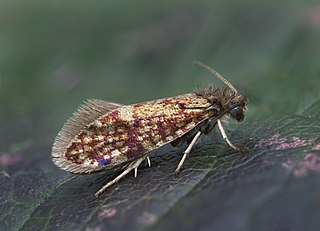
Eriocrania cicatricella is a moth of the family Eriocraniidae found in Europe. It was first described by Johan Wilhelm Zetterstedt in 1839. The larvae mine the leaves of birch.

Eriocrania salopiella is a moth of the family Eriocraniidae and is found in Europe. It was described by the English entomologist, Henry Tibbats Stainton in 1854. The larvae mine the leaves of birch.

Eriocrania sparrmannella also known as the mottled purple is a moth of the family Eriocraniidae, found in Europe and Japan. It was first described by the French entomologist, Louis Augustin Guillaume Bosc in 1791. The specific name honours the Swedish naturalist Anders Erikson Sparrman. The larvae mine the leaves of birch.

Eriocrania unimaculella is a moth of the family Eriocraniidae found in Europe. It was first described by the Swedish naturalist Johan Wilhelm Zetterstedt in 1839. The larvae feed inside the leaves of birch, making a mine.

Eriocrania chrysolepidella is a moth of the family Eriocraniidae found in Europe. It was first described by the German entomologist, Philipp Christoph Zeller in 1851. The larvae mine the leaves of hazel and hornbeam.

Parornix anglicella is a moth of the family Gracillariidae found in Asia and Europe. It was described in 1850, by the English entomologist Henry Tibbats Stainton, from a specimen from Lewisham, Kent.
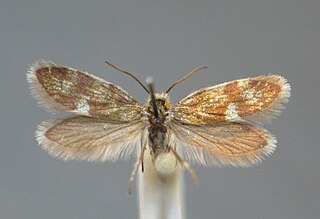
Eriocrania is a Palearctic genus of moth of the family Eriocraniidae. The moths are diurnal, flying in sunshine, and the larvae are leaf miners, forming blotches in leaves.
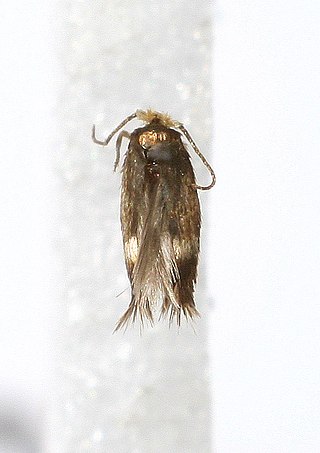
Stigmella microtheriella, the Hazel leaf miner moth, is a moth of the family Nepticulidae. It is found in Asia, Europe and New Zealand. The larvae mine the leaves of hazel and hornbeams. It was described by the English entomologist, Henry Tibbats Stainton in 1854 from a type specimen found in England.

Stigmella lapponica is a moth of the family Nepticulidae found in Asia, Europe and North America. It was first described by the German entomologist, Maximilian Ferdinand Wocke in 1862. The larvae mine the leaves of birch.

Stigmella plagicolella is a moth of the family Nepticulidae described by Henry Tibbats Stainton in 1854. It is found in all of Europe and the Near East.
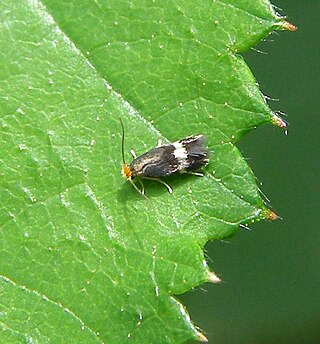
Stigmella aurella is a moth of the family Nepticulidae found in Africa, Asia and Europe. It was first described by the Danish zoologist, Johan Christian Fabricius in 1775. The larvae are leaf miners.

Stigmella salicis is a moth of the family Nepticulidae which is found in Europe. It was first described by the English entomologist, Henry Stainton in 1854. The type locality is from England.

Stigmella perpygmaeella is a moth of the family Nepticulidae, found in most of Europe, east to Russia. The larvae mine the leaves of hawthorns.

Ectoedemia intimella is a moth of the family Nepticulidae which is found in Europe. It flies in June and July and the larva mine the leaves of willows from July to November.

Micropterix tunbergella is a moth of the family Micropterigidae found in most of Europe. The moths are very small and can be found feeding on the pollen of hawthorn, oak and sycamore. The larva and pupa are unknown. The moth was described Johan Christian Fabricius in 1787.
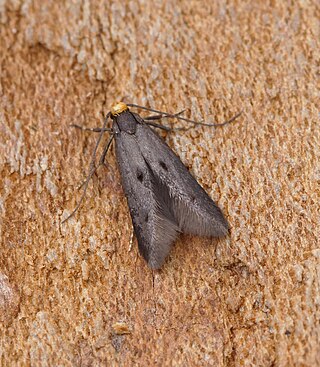
Spuleria is a genus of moths of the family Elachistidae. It contains only one species Spuleria flavicaput, which is found in most of Europe and Anatolia. The larvae mine the twigs of hawthorns.

Coptotriche marginea is a moth of the family Tischeriidae, found in most of Europe. It was named by the English botanist, carcinologist and entomologist, Adrian Hardy Haworth in 1828, from a specimen found in England. The larvae mine the leaves of brambles (Rubus) species.





















